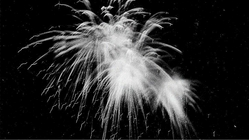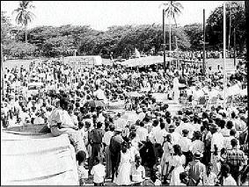Jamaica Celebrates - Remembering '62
Published: Sunday | August 2, 2009


File photos LEFT: FIREWORKS EXPLODE:Streaks of light illuminate the midnight sky as a new nation is born.
RIGHT: A section of the crowd, estimated at 5,000 people, which attended the St Thomas Parish Fête at Lyssons Recreation Centre, near Morant Bay on Thursday, August 9, 1962, for the Independence celebrations.
Sadeke Brooks, Staff Reporter
Just before midnight on August 5, 1962, the British Union Jack was lowered and the Jamaican flag raised for the first time, marking Jamaica's independence and the dawn of a new era.
The national parade, flag-raising ceremony and fireworks were held at the National Stadium with the evening's events beginning at 11 p.m. More than 20,000 people gathered at the venue for the night's celebrations.
At one and a half minutes to midnight, the first verse of the British anthem was played. The lights on the 60-foot pylons were put out and darkness descended upon the arena. In the hush that followed, the Union Jack, which waved over Jamaica for 307 years, was hauled down. Then 30 seconds to midnight, the lights came on again and the Jamaican flag was raised to the top of the flagpole. Then, both verses of the national anthem were played.
Dignitaries
At the ceremony were the governor, Sir Kenneth Lightbourne, Jamaica's first governor general, his wife, Lady Lightbourne, and Jamaica's premier, Sir Alexander Bustamante, who was later sworn in as prime minister.
Also present were Princess Margaret, who was representing The Queen, and her husband, the Earl of Snowdon. There were also dignitaries from many countries such as the United States, Australia, Pakistanand the United Kingdom.
This aspect of Jamaica's celebration of independence was the most significant for former prime minister, Edward Seaga.
"There was a glorious display of fireworks that went on for quite a while. It was very emotional because I was very involved in the event. I campaigned for it (Independence). It brought me to tears," said Seaga, who was minister of development and welfare in the Jamaica Labour Party-led government.
First government
The Jamaica Labour Party formed the first government of independent Jamaica, having beaten the People's National Party, by polling 72.88 per cent of the voters in the election that was held on April 10, 1962. This was after the Jamaican people voted against joining the West Indies Federation in 1961.
The lowering of the flag was also a significant aspect of the celebration for Merrick Needham, who is now a commissioner at the Jamaica Cultural Development Commission (JCDC).
"It was the Union Jack being lowered for the very last time and the new flag being raised for the first," said Needham, who was the director of programmes and production for the 1962 celebration. He was the lead commentator for the Jamaica Broadcasting Corporation (JBC) and coordinated the JCDC's coverage of the Independence celebration.
"There was concern that there would be trouble, but the people behaved absolutely impeccably," said Needham.
He also said that it was a difficult task to prepare for the celebration that spanned the entire island. It was also a challenging task for the technical crew at JBC where he worked at the time.
Current JCDC chairman, Hugh Nash, said he had to work across the island for the celebrations.
"I was handling things outside of Kingston. There was something in every single parish and it was not confined to the parish capitals," Nash said.
For instance, in Clarendon, there were celebrations in Lionel Town, May Pen and Chapelton. St Catherine had activities in Spanish Town, Ewarton and Old Harbour.
August 5, 1962 was also the national day of prayer. As such, dedication services were held in every church in the island with the following two days being public holidays. On August 6, there were further celebrations across the island and August 7 marked the opening of Parliament for independent Jamaica. There was also an Independence state banquet. On the same day, there were also numerous street dances. For the period, approximately 100 street concerts were organised bythe JCDC.
In addition, Nash said, there was a fisherman's regatta on every beach.
Spectacular parade
The national float parade was held on August 11. More than 5,000 people participated in the giant parade with about 90 floats. The parade started in Cross Roads and went down Slipe Road, east at Torrington Brigade, around North Race Course Road, down East Race Course Road, down East Street, west into Harbour Street and up King Street.
The parade was led by Miss City of Kingston, Mitsy Constantine. There were floats from groups like the Jamaica Youth Club Council, Jamaica Industrial Development Corporation, Alcan, Jamaica Manufacturers' Association and Esso.
There were also marchers from the Jamaica Library Service, footballers, horse-riders, tennis and hockey groups, the security forces, and uniform groups like the Cadets, Scouts, Guides, Boys' Brigade and the parade of the churches with massed choirs singing.
Effigies of Louise Bennett, Ranny Williams, Alexander Bustamante were also present.
Jamaica's Independence was heavily publicised in nearby territories, especially in the Panama Tribune.
In addition, The Gleaner Company and N.V. Phillips of London made ten 23-inch television sets available for the viewing of the celebration at Victoria Park, Kingston.
Leading up to the celebrations, certain key things had to be finalised. The design of the flag was chosen through a collaborative effort by government officials. The motto, 'Out of many, one people', was chosen by Legislature in 1962. The national anthem was written by Reverend Hugh Sherlock, while the music was provided by Robert Lightbourne. The national symbols were chosen by a select committee in the Jamaica Horticultural Society.
Nash said volunteers played a key role in the '62 celebrations. Without a copy of the actual figures, Nash estimates there were about 500 volunteers in each of the 12 parishes outside Kingston and St Andrew. That means there would have been approximately 6,000 volunteers in those parishes. In the Corporate Area alone, Nash said there could have been another 5,000 volunteers.
As for the cost, Nash said the British government assisted Jamaica with project advisors.
Seaga was also unable to give actual figures. However, he said Britain also gave Jamaica a parting gift, having been its sovereign for more than 300 years.
"Britain converted some existing loans to grants and signed over the lands at Up Park Camp to the Government of Jamaica. It was not intended to be a substantial value; it was more a token and symbolic," Seaga told The Sunday Gleaner.
A time of happiness
At that time, Needham said, it was a time of happiness for the people.
"I think there was a lot of hope in those days. It was the beginning of progress in terms of education and marked deterioration in others like criminality," Needham said.
Since that time, a few things have changed. After the flag-raising ceremony in 1962, there was a much smaller celebration for the anniversary of Independence in 1963. But in 1964, a structured Jamaica Festival began, where there was a parade, as well as a showcase of arts. In 1997, when Emancipation Day was introduced as a national holiday on August 1, celebrations started from July 31 and ended on Independence Day, August 6. As time progressed, Jamaica Festival was separated from the Jamaica Festival of the Arts.






















